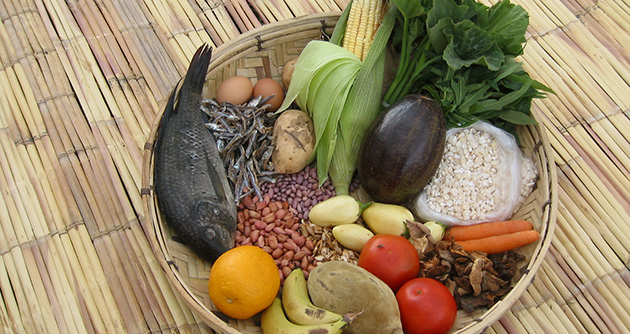
In July 2014, FANTA and the Food and Agriculture Organization of the United Nations (FAO) convened a meeting at which technical experts representing academia, research institutions, United Nations organizations, and donor agencies reached consensus on a global dietary diversity indicator for assessing the quality of women’s diets. The indicator, Minimum Dietary Diversity – Women (MDD-W), reflects women’s consumption of at least 5 of 10 food groups throughout the previous day and night. Research has shown that women who consume at least 5 of the 10 MDD-W food groups over a 24-hour period are more likely to have a diet higher in micronutrient adequacy than women who consume fewer than 5 of the 10 MDD-W food groups.
The MDD-W was developed in response to a long-standing need—while women’s diets can have a considerable impact on their health and well-being as well as on that of their children, there previously were no simple, effective indicators to assess women’s diet quality. Moreover, demand for a simple indicator of women’s dietary diversity has intensified in recent years due to an increased focus on nutrition-related programming, including efforts to improve the health of women and children during the critical 1,000-day period between the beginning of pregnancy and a child’s second birthday.
The development of the MDD-W was undertaken by the Women’s Dietary Diversity Project in two phases (WDDP I and WDDP II). In the first phase (2005–2010), FANTA collaborated with several research institutions including the International Food Policy Research Institute (IFPRI), the Institute of Research for Development (IRD), Iowa State University, Wageningen University, Fafo Institute for Applied International Studies, and the University of North Carolina to evaluate if any one of eight candidate food group indicators could serve as a proxy for the micronutrient adequacy of women’s diets. The partners used existing datasets with dietary intake data from 24-hour recall to analyze the relationship between each of the eight simple indicators of dietary diversity and the micronutrient adequacy of women’s diets in five resource-poor settings.
Based on the research—which was featured as a Special Supplement in the Journal of Nutrition in 2010—several candidate indicators were proposed as valid for possible use. USAID’s Feed the Future initiative and the Office of Food for Peace adopted one of these proposed candidate indicators (an indicator based on 9 food groups) for use in their monitoring and evaluation results frameworks.
In the second phase of the WDDP (2012–2014) FAO—in collaboration with IRD, Biodiversity, FANTA, HarvestPlus, and the University of California, Davis (UC Davis), and with support from the European Union—undertook additional analyses with the objective of identifying and proposing a dichotomous indicator for global use. Building on the initial research from the first phase of the WDDP and using additional datasets, two candidate indicators—the 9-food group indicator identified as part of the WDDP I work and a new 10-food group indicator—were identified to propose for consideration by technical experts at the July 2014 consensus meeting. After lengthy discussions, the experts unanimously recommended the 10-food group MDD-W and agreed to a cutoff of 5 or more food groups during the previous day or night to indicate minimum dietary diversity for women.
As a next step, FANTA is collaborating with UC Davis and FAO to develop a manual to provide instruction for how to collect and tabulate data for the MDD-W. Since the July 2014 meeting, there have been calls to include the indicator in “post-2015” initiatives that build on the Millennium Development Goals. In addition, USAID’s 2014 Multi-Sectoral Nutrition Strategy includes measurement of women’s dietary diversity as one of six outcome-level indicators for use in USAID-assisted countries.


